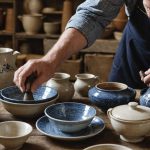Overview of Traditional UK Pottery
The history of UK ceramics stretches back thousands of years, reflecting the evolving craftsmanship and artistry over centuries. Pottery in the UK originated from the necessity of daily life, evolving into a revered art form with cultural significance. This transformation highlights the adaptability and creativity inherent in traditional pottery.
Traditional pottery techniques in the UK vary significantly, reflecting regional influences and resources. Techniques such as hand-building, wheel-throwing, and slip casting were widely used, each contributing uniquely to the texture and form of the ceramics produced. These methods often involved hours of meticulous work and a profound understanding of material properties.
Also to read : Discovering the UK”s Historic Canal Systems: Your Ultimate Guide to Unforgettable Guided Tours
The variety of pottery styles in the UK further showcases this rich tradition. Notable styles include Staffordshire pottery, known for its intricate designs and vibrant glazes, and Wedgewood’s jasperware, celebrated for its neoclassical motifs and elegant matte finishes. These styles not only highlight the diversity of UK ceramics but also its influence on global pottery trends.
In essence, UK ceramics is not just about crafting functional items; it’s a testament to the nation’s artistic journey, marking its place in both cultural heritage and contemporary design.
Additional reading : Top Scenic Cycling Trails to Discover the Charm of the English Countryside
Top Locations to Experience Pottery-Making
Exploring pottery-making involves discovering both studios and workshops that offer unique and authentic experiences.
Notable Pottery Studios
In the UK, several pottery studios stand out for their signature styles and diverse offerings. Studios such as Leach Pottery in St Ives are known for their traditional Japanese and English techniques. They offer visitors hands-on experiences where one can delve into these unique methods. Clay Studio in London, on the other hand, showcases contemporary styles, providing an immersive experience in modern ceramics.
Visitors can engage through workshops, gallery visits, or simply observing artisans at work. Many studios provide options to join short courses, allowing individuals to explore their creativity and understand the nuances of pottery-making in a professional environment.
Recommended Ceramics Workshops
Interactive pottery workshops are essential for those seeking a more immersive experience. Ceramic Arts Workshop in Birmingham offers a variety of class formats from one-day intenses, to weeklong creative retreats. These workshops focus on wheel-throwing, hand-building, and glazing techniques, suitable for all skill levels. Participants can craft their own pieces and benefit from a hands-on approach, gaining practical knowledge and personal satisfaction.
Galleries Showcasing Traditional Pottery
Galleries like the British Museum in London house significant pottery collections, allowing visitors to appreciate both contemporary and traditional ceramics. These galleries often host exhibitions, such as the “Shaping the Earth” series, which focuses on diverse cultures and time periods. Seasonal displays ensure a dynamic experience, catered to both enthusiasts and casual visitors alike.
Types of Ceramics Produced in the UK
In the UK, the diversity of ceramic types reflects a rich cultural heritage. Common ceramics include stoneware and earthenware. Stoneware is fired at higher temperatures, making it durable and often used for practical items like mugs and bowls. Earthenware, on the other hand, is fired at lower temperatures, resulting in more porous and less durable products, often utilised for decorative pieces.
Design Techniques
The artistry of UK ceramics is further enriched by various design techniques. Glazing is a popular method, providing a glossy finish and making the piece watertight. Artists often use embossing to add intricate patterns and textures, elevating the visual appeal of the pottery. These techniques are not only functional but are integral in defining the traditional pottery forms prevalent in British craftsmanship.
Local Materials
Local materials play a crucial role in these ceramics. Clay sourced from different regions of the UK contributes to the unique texture and colour variations seen in British pottery. The availability and characteristics of local clays shape both the aesthetics and the practical aspects of the ceramics, linking each piece to its geographic origins and cultural context.
The Cultural Significance of Pottery in the UK
Pottery has long played a central role in the cultural tapestry of the UK, representing both tradition and innovation. Rooted deeply in local communities, pottery culture serves as a bridge between past and present, maintaining its status as a cherished heritage craft.
In various communities, pottery was historically more than mere utilitarian objects; it held social and spiritual significance. For instance, specific colors and patterns in pottery could identify regional identities or serve ceremonial purposes. Today, traditional pottery continues to preserve this heritage, with craftspeople dedicated to ancient techniques handed down across generations. These artisans not only maintain traditional skills but also nurture cultural storytelling through their creations.
However, contemporary influences have also left their mark on the ceramics tradition. Artists incorporate modern designs, materials, and technologies, breathing new life into time-honored practices. This blending of old and new not only enriches the cultural fabric but also ensures that pottery remains relevant and accessible to a wider audience. By balancing traditional craftsmanship with innovative elements, pottery culture in the UK showcases the dynamic and evolving nature of heritage crafts, always poised to capture imagination while preserving the essence of the past.
Tips for Visiting Pottery Locations
Exploring pottery studios can be an enriching experience, and proper planning is essential to make the most of your visit. Here are some visitor tips to enhance your pottery encounters.
Start by researching studios in the area to identify ones that offer workshops or classes—an excellent way to immerse yourself in pottery experiences. Check schedules beforehand, as some studios require reservations. To deepen your involvement, consider joining local pottery events. Many communities host seasonal events or festivals celebrating pottery, offering a chance to witness artists at work, buy unique pieces, and even try your hand at crafting. Timing your visit to coincide with these festivals can provide an unforgettable experience.
When planning your trip, don’t forget to explore what else the area has to offer. Many pottery locations are near attractions like museums, parks, or markets. This allows you to extend your day and enjoy a broader cultural experience. Also, look for local accommodations that cater to art enthusiasts, often providing a cozy and inspiration-filled stay. With these tips in mind, you’re set for a truly memorable pottery adventure!
















